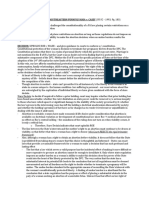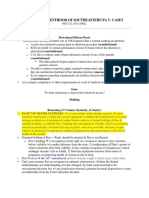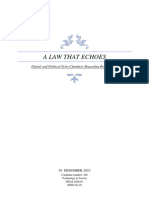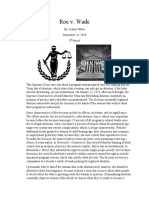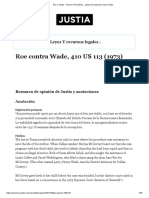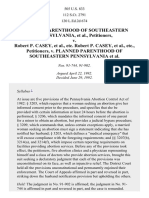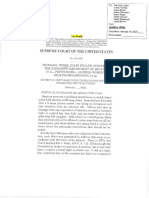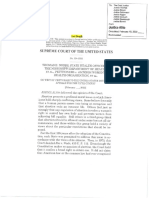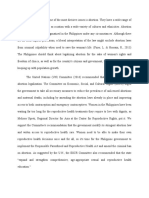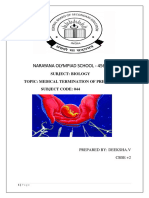Alaqwari
Sireen Alaqwari
Professor Carlson
POLSCI-2
06 December 2024
Roe v. Wade
In recent generations, many states, including Texas, have opposed failure societies,
challenging the criterion settled in a piece milestone 1973 Supreme Court conclusion in Roe v. Wade.
These laws, such as Texas Senate Bill 8 (SB8),
demand harsh disadvantages on failure access and have burnt debates over civil liberties.
This paper tries to examine the constitutional associations of these regulations, focusing on the
progress of failure rights in the United States, the challenges formalized by new limits, and the more
extensive impact on rights regarding solitude under the Fourteenth Amendment.
Roe v. Wade was a life-changing Supreme Court conclusion that settled a girl's constitutional
right to pick a failure. In 1973, the Court ruled 7-2 that the right to solitude, though not noticed in the
Constitution, is shielded under the Due Process Clause of the Fourteenth Amendment (Roe v. Wade,
1973; Oyez, n.d.). This right includes a girl's conclusion to terminate a pregnancy, equalized against
the United States of America's interests in insulating motherly strength and potential existence (Roe
v. Wade, 1973).
The Court approved a trimester framework to balance these interests. During the first
trimester, the resolution to abort was restored only accompanying the girl and her physician. In the
:
� second trimester, states commit organized failure to preserve motherly health. In the third trimester,
formerly the fetus reaches living, states could stop failure except when unavoidable to look after the
mother's growth or energy (Roe v. Wade, 1973). This framework provided clear guidelines, though it
faced criticism from both abortion rights advocates and opponents (Greenhouse, 2005).
Subsequent cases, Planned Parenthood v. Casey (1992), changed Roe by replacing the
trimester foundation accompanying the "unnecessary burden" standard. This standard prohibits states
from accomplishing societies that place a solid impediment in the way of a girl pursuing an abortion
before animation (Planned Parenthood v. Casey, 1992). While Casey reaffirmed the
principal possession of Roe, it admitted for better state rule of failure, background the entertainment
industry for the current wave of provisional societies.
In current years, conservative-tendency states have passed standards devised to weaken Roe
and inflame a Supreme Court reassessment. Texas SB8, accomplished in 2021, is an individual of
ultimate contrary failure laws in the country. It bans abortions after nearly six weeks of pregnancy
before many daughters are even knowledgeable they are pregnant and delegates applications to
private citizens, the one can charge one supporting or abetting a failure (Sullivan, 2021). This novel
application device aims to fool combined judicial review and has inspired meaningful dispute.
Another important case, Dobbs v. Jackson Women’s Health Organization (2022),
complicated a Mississippi society banning most abortions after 15 weeks. In a 6-3 resolution, the
Supreme Court upside-down Roe, contending that the Constitution does not hold the
right to failure and returning the issue to individual states (Liptak, 2021), formerly the fetus reached
living, states could stop failure except when unavoidable to look after the mother's growth or energy
(Roe v. Wade, 1973). This framework provided clear guidelines, though it faced criticism from both
abortion rights advocates and opponents (Greenhouse, 2005).
Subsequent cases, Planned Parenthood v. Casey (1992), changed Roe by replacing the
trimester foundation accompanying the "unnecessary burden" standard. This standard prohibits states
from accomplishing societies that place a solid impediment in the way of a girl pursuing an abortion
:
� before animation (Planned Parenthood v. Casey, 1992). While Casey reaffirmed the principal
possession of Roe, it admitted for better state rule of failure, background the entertainment industry
for the current wave of provisional societies.
In current years, conservative-tendency states have passed standards devised to weaken Roe
and inflame a Supreme Court reassessment. Texas SB8, accomplished in 2021, is an individual of
ultimate contrary failure laws in the country. It bans abortions after nearly six weeks of pregnancy
before many daughters are even knowledgeable they are pregnant and delegates applications to
private citizens, the one can charge one supporting or abetting a failure (Sullivan, 2021). This novel
application device aims to fool combined judicial review and has inspired meaningful dispute.
Restrictive abortion laws also keep health inequities by complicating existent barriers to
healthcare. For instance, states accompanying the tight failure restrictions frequently have higher
maternal humanness rates, particularly with Black women (Guttmacher Institute, 2022). These
outcomes underline the interconnectedness of failure rights accompanying broader issues of
ethnic and financial justice.
From a constitutional view, the Dobbs decision has unlocked the door for states to challenge
other civil liberties implanted uncommunicative. For example, Justice Clarence Thomas, in his
approving belief in Dobbs, suggested revisiting marker conclusions such as Griswold v. Connecticut
(access to contraception), Lawrence v. Texas (decriminalization of same-sex intimacy), and
Obergefell v. Hodges (same-sex marriage) (Liptak, 2022). While most beliefs in Dobbs stated that
the resolution applies only to failure, legal scholars note that the reasoning used to overturn Roe
erodes protections for other rights not noticed in the Constitution.
The constitutional suggestions of current failure limits are far-reaching, suggesting issues of
federalism, individual rights, and public impartiality. The overturning of Roe v. Wade shows a
moment of truth in U.S. permissible history, changing the balance between state and
combined expertise and redefining the opportunity of constitutional solitude protections. As the
country Report
with its government navigate this new legal landscape, the debate over failure rights will
:
� certainly resume, indicating deeper societal estrangements about the role of administration in
private administration.
References
ACLU. (2022). The overturning of Roe v. Wade: What it means. American Civil Liberties Union.
Retrieved from https://www.aclu.org
Guttmacher Institute. (2022). The impact of abortion restrictions on people and families. Guttmacher
Institute. Retrieved from https://www.guttmacher.org
Greenhouse, L. (2005). Becoming Justice Blackmun. Times Books.
Liptak, A. (2022, June 24). Supreme Court overturns Roe v. Wade. The New York Times. Retrieved
from https://www.nytimes.com
Oyez. (n.d.). Roe v. Wade. Oyez. Retrieved from https://www.oyez.org/cases/1971/70-18
Ramaswamy, A., & Dyer, E. (2022). Inequities in abortion access after Roe. Health Affairs.
Retrieved from https://www.healthaffairs.org
Sullivan, K. (2021). What Texas SB8 means for abortion access. CNN. Retrieved
from https://www.cnn.com
Edit with the Docs app
Make tweaks, leave comments, and share with
others to edit at the same time.
NO THANKS GET THE APP
:



